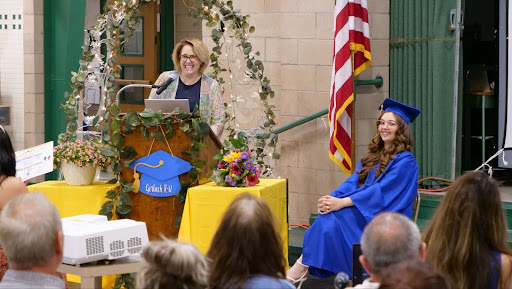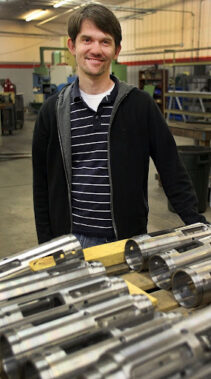The global Burning Man community is full of people whose daily lives are as dynamic and creative as their time in Black Rock City and at Regional Events around the world. Teachers, mayors, engineers and entrepreneurs — many bring their professional skills to Burning Man… where they develop new capabilities that in turn transform how they work in the world.
The magic of Burning Man has never been just about the art or the play. So much is about the work — the planning, collaboration, building, and problem-solving — that re-form our character and reveal our potential. Those same acts of collaboration and creativity, learned in an ephemeral city or gathering, become tools for how we live and lead the rest of the year.
This story explores just some of the many ways Burners weave those lessons into their professional callings. While the three Burners profiled happen to be Black Rock Rangers, they embody lessons anyone can apply. Every camp lead, every kitchen volunteer, and every art builder learns the same truth: the work is the practice.
Every participant has a story to tell and we’d love to hear yours! What have you taken away from Black Rock City and how did you apply it in the broader world? Email your story to jackrabbitspeaks@burningman.org.
Elected Office: Micro-wins in the Civic Imagination
Catherine Carlton, who goes by Ranger Monster on playa (“for my monster hugs”), first came to Black Rock City not as a participant, but as the mayor of Menlo Park, California. “I was attending a conference where Burning Man Project came and spoke about building community and sustainability,” Cat recalls. “They had a program to bring mayors out to the Burn, and I took advantage of it.”
Cat arrived curious and a little skeptical and, like so many, left a true believer.
A few years later, Cat became a Black Rock Ranger after a personal encounter with their care. “I had gotten overheated and passed out,” she says. “The Rangers came and made sure I was okay. They came back later to check on me. I thought, Wow, that’s really special. It would be really fun to help people like that.”

As a civic leader, Cat recognizes the value of the risk and innovation she sees in the way Rangers go about resolving conflicts and offering their knowledge in so many other ways. “Being an elected official is really tough,” Cat admits. “There’s a portion of the population just waiting for you to make a mistake. That makes leaders risk-averse. At Burning Man, you see micro-wins all the time — camps running on solar, doing great recycling projects. Being able to show those micro-wins is great.”

Cat sees that experimental spirit as the heart of progress. “People from all over the world come to Burning Man,” she said. “A lot of the research that comes out of Harvard talks about how, in the business world, the more diversity of thought you have, the better the decision-making. You have access to a tremendous amount of diversity here.”
In her current international work speaking at events and mentoring impact start-up leaders, Cat doesn’t bring home the spectacle of Burning Man, but its civic blueprint — the faith that creativity and compassion can coexist in governance.
Whether in a khaki Ranger uniform or in a suit at City Hall, her work is the same: to build a culture where everyone has a place and small experiments light the way forward.
A Principal Integrating the 10 Principles
Each year on their way to Black Rock City, close to 70,000 people pass through the tiny town of Gerlach Nevada, population 53 (according to census.gov as of 2023). Ranger Keeper, known off playa as Stacey Black, lives there and leads an institution with similar DNA to the Black Rock Rangers: The Gerlach K-12 School.
“One of the features of the Rangers,” Stacey says, “is riding the edge of chaos. The Rangers are kind of a Catcher-in-the-Rye type of vibe, helping people stay safe, helping them have whatever experience they want to have.”

Stacey has carried this ethos into the school she’s led since its population collapsed, following closure of the gypsum mine in nearby Empire, Nevada (where many of the school’s students lived). “When that happened, we went from about 85 students down to eight,” Stacey recalls. “We told the district: ‘If you close the school, you’re going to kill the town. And that’s not an option.’”
Her solution was to rebuild the Gerlach K-12 School using the same ingredients drawn upon by many a theme camp: collaboration, and creativity borne of constraint, deep care, and unflagging devotion to her students.
The Gerlach K-12 School is a unique educational institution that calls for innovative and unconventional approaches. To foster that mindset, Stacey also draws on some of the same practices Rangers use to hold space in the dust.

“Good teachers do a similar thing to what happens inside of Rangers.” Stacey says. “They build a room that’s ripe for learning and exploration. A place where it’s okay and, in fact, encouraged to make mistakes, try new things, and find your way.”
Every year in her role as Principal Black, Stacey takes her students on a field trip to the Black Rock City build site. They tour the Man Pavillion, the Temple, and meet a collection of Black Rock City’s builders and artists. “I want our students to feel proud of where they live,” Stacey said. “To embrace that idea of stewardship of the Black Rock Desert.”
For Stacey, the lesson is simple but profound: “We have some level of responsibility to build spaces that reflect the values that we want to see in the world. We want to see art and creativity. And we have a city that reflects art and creativity, a place that’s a living, breathing art exhibit and playground.”
Leadership means making room for trial and error, what Stacey calls “a room that’s ripe for learning,” and what Cat Carlton recognizes in her field as a kind of civic courage elected officials can muster to try new things to make their city, county, or state better. Both women see Burning Man as a rehearsal space for that kind courage. It’s a place where failure isn’t fatal, it’s formative.
Listen to Ranger Keeper’s full story and further thoughts on Rangering and principal-ing on the Burning Man LIVE podcast:
Entrepreneurship: Leading Through Chaos
Ranger Tulsa, who goes by Curtis Kline back at home in Tulsa, Oklahoma, has been volunteering as a Black Rock Ranger since 2000 when he first stumbled across the Rangers section of the Burning Man Project website. “It just spoke to me,” Curtis said. “I instantly knew that’s where I needed to be.”
Curtis has since spent decades serving as a Ranger in Black Rock City, while running companies back home — including his family’s manufacturing plant, a boutique road bike business, and a backcountry first aid kit purveyor.
“The thing that motivates me about being a Ranger,” Curtis says, “is helping people and being key to people’s positive experience at Burning Man.”
That practice of problem-solving, with a heaping dose of empathy that’s so essential to Ranger-ing, is an approach Curtis carries directly into his business ventures. “Rangering involves dealing with a lot of different things, sometimes all at once,” he explained. “In a six-hour shift you might face law-enforcement coordination, a serious medical situation, and an interpersonal conflict. I think that’s something startup founders and entrepreneurs face all the time. Just dealing with the chaos.”
To separate the signal from the noise, Curtis also relies on one of the most transferable tools: assessing interest versus position. “People tell you their stated problem, but what we’re looking for is the actual problem underneath. I find that to be really useful in my professional life too — just digging a little deeper than whatever the stated problem is.”
If you’re curious about Ranger learnings, check out the publicly available Ranger Conflict Resolution and De-escalation Training on Burning Man Hive.
For Curtis, Burning Man’s principles show up not just in business, but in how he moves through the world. “I can connect my work as a Ranger to Civic Responsibility,” he said, “but the principle I hold onto the most is Radical Inclusion. A lot of people who are struggling at Burning Man are struggling because they feel excluded. I help people understand they can be part of the community.”
That instinct extends into Curtis’ professional world. Sober for more than two decades, Curtis hires people from his recovery community, whose addiction history might otherwise prevent them from finding work.
The kind of leadership Curtis practices in his work — steady, inclusive, and unflustered by chaos — mirrors what Stacey brings to her school and what Cat has modeled in elected office. Whether in a boardroom, a classroom, or a city council chamber, these three have learned the lesson from Burning Man that leadership means creating conditions where people can grow, experiment, feel included, and truly connected to their purpose and greater community.
The Work Continues — with Creativity, Wherever You Are
Bringing Burning Man home isn’t about leaving one life behind for another. It’s about carrying the principles into whatever comes next — into classrooms, boardrooms, town halls, and homes.
When participating in Burning Man sparks new ideas and connections, Burning Man Project celebrates that inspiration and action. Because the real city we’re building together isn’t an ephemeral metropolis, in the dust or elsewhere. It’s in our neighborhoods, our lives, and our workplaces.
Do you have a Burning Man leadership lesson that ties together your Burner and real-world roles? We’d love to hear about it. Email your story to jackrabbitspeaks@burningman.org.
Cover image of happy campers building together, 2024 (Photo by Mark Mennie)



